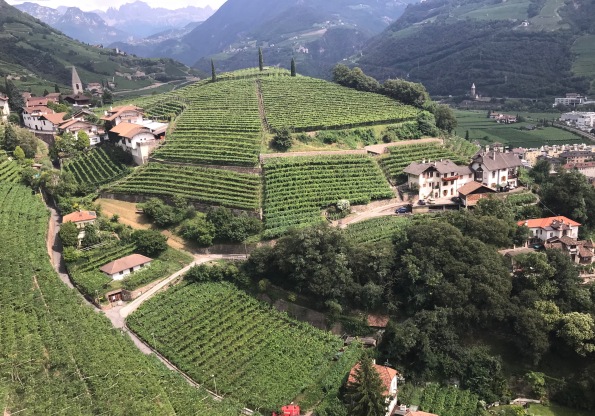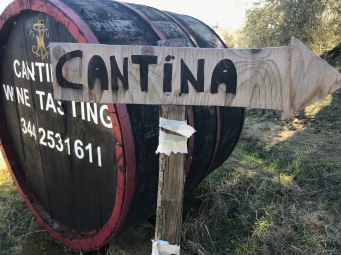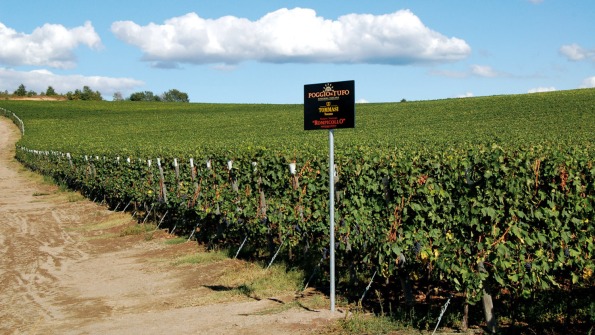Archive
What makes a wine great isn’t a number or a score

Steep hillside vineyards near Bolzano, Italy, illustrate the lengths to which wine makers will go to produce a memorable bottle of wine. Photos and story – Dave Buchanan.
Please indulge me while I share two separate conversations I heard recently.
The first from an acquaintance who recently returned from a late-fall trip to Napa Valley.
He and his wife, both discerning wine people with an appreciation for California-style wines, were visiting friends who introduced our couple to a fairly new but already successful winemaker.
During that initial conversation, the three quickly bonded and soon the winemaker was inviting his new friends to visit his winery, which normally isn’t open to the public. During a late lunch after touring his vineyards and winery, the winemaker graciously opened a couple of bottles from his personal library.
No sales pitch, no pressure, simply a gesture of friendship at our friends’ interest.
The wine, said my friend, “was a Cabernet (Sauvignon) and was simply stunning.”
Not surprisingly, at least to me, our well-funded friends brought a couple of these bottles back home to Colorado.
The second conversation, similar but with its roots 6,000 miles away, began when another acquaintance, this one a wine importer from Denver, remarked how he had met “too many to count” winemakers and their representatives while attending a wine festival in Verona, Italy.
“Almost everyone implored me to visit their winery and hear their story,” this friend recalled. So my friend, an impulsive sort, decided to take advantage of a couple of invitations.
“I saw some amazing estates and some tiny places where one family did all the work,” he said. “And mostly I tasted the same wines there that I tasted in Verona.”
But while sharing lunches and dinners in out-of-way bistros and private homes, he also got an insider’s peek at how Italians view their wines and its role in the everyday life. He gladly paid the extra baggage fees after being gifted a few bottles of Sangiovese-based Vino Nobile di Montepulciano.
Here is where our stories converge.

Nothing says ‘Welcome’ better than a friendly sign outside a neatly run winery.
Both men said that after arriving home, they invited over some friend to share the wines and hear their stories. And both, unknowingly but in similar words, told how the wines showed well but somehow something was missing.
“It’s not that the wines were less than great, they just weren’t that great, not like I remember,” said one.
“Everyone said nice things about the wine and were entertained to hear about how the winemaker’s grandfather had saved his wine from the Germans during World War II by hiding it under the stable,” said the other. “But to me, it just wasn’t the same wine.”
I was fortunate to taste both wines and both were way above what I normally drink. So it probably wasn’t the wines that were lacking. It was, both men affirmed, the experience of being there that made these wines memorable.
Seeing the vineyards, walking through the cellars, listening to the wine as it ages in the barrels, sharing a man’s or a family’s story. This, in great part, is what makes an unforgettable wine. Fortunately, both of these man realize that and neither is in any way disappointed by the wines.
“It’s always expectations versus reality,” one mused. “I know it won’t be the same once I get home but I want so much to share the experience.”
Today, social media (and extra baggage fees) allow us to share, from a distance both special and temporal, some of that experience. Still, it’s but a tantalizing taste of what wines are, what they can be, and what they mean to the people who make them.
Winter nights warmed by memories of Etruscan vineyards.

The Tommasi Family’s Poggio al Tufo vineyards near Pitigliano, a historical Etruscan city in the Maremma an hour or so north of Rome. Photo courtesy Tommasi Family Estates.
Sometimes, when the days are short and cold and summer is but a memory, I spend winter hours looking for wines that remind me of warmer times and sunnier climes.
I recently found two wines that took me back to a few days late last spring spent wandering the vineyards of the Veneto and Tuscany. Both wines are from Tommasi Family Estates, the 115-year old company now in its fourth generation of winemakers with its base in the heart of the Valpolicella Classico region of the Veneto.
Tommassi, named after founder Giacomo Tommasi, has vineyards in four regions: Veneto; Olto Pavese in Lombardy; Tuscany (Montalcino and Maremma); and Manduria, in Puglia. From each of these regions come wines as distinct and unique as the vineyards where they grow.
The event was a simple gathering of good friends for a holiday dinner and talk, a simple yet warm get-together so remindful of previous dinners spent at the homes of winemakers around the world, where formality drops away and the talk turns to the state of wine in general along with family, current politics and wherever the mood take us.
Tommasi Ripasso DOC Valpolicella Classico Superiore 2013 – As we all know, the story of Ripasso wines is intertwined with the story of Valpolicella and Amarone. Briefly, a Ripasso is made by refermenting Valpolicella on the skins left after Amarone is fermented. The result is a wine that’s darker and more intense in flavor than the original Valpolicella and goes well with winter-style comfort foods or even a grilled steak in the summer.
You could call a Ripasso a “baby Amarone” because the former uses the same grape varieties that go in Amarone (Corvina, Rondinella and, in this case, Corvinone) and you get some of the same aromas: dark cherries, dried cranberries, heather, and spice.
But it’s less-expensive, generally in the $20-25 range.
We had this wine with grilled chicken, fresh green salad and homemade bread. You would have thought it was July until the wind howled and snow blew past the windows.
Tommasi Poggio al Tufo Rompicollo Toscana IGT 2013 – We opened this wine for the cheese course and while there’s nothing overwhelming about the wine, it brought a smile to everyone’s face. Maybe that’s the key – it’s not overwhelming, it just goes well with food and good company.
Plus, it’s one of those rare finds that is affordable, very tasty and pairs well most lighter meats, pastas and cheeses. And, if you’re into this sort of thing, you can close your eyes, take a sip and imagine you’re in the Tommasi vineyard in the historic Etruscan area of sunny Maremma in southwestern Tuscany, midway between the Tyrhennian Sea and Rome.
The wine is a blend (60 percent Sangiovese, 40 percent Cabernet Sauvignon) from a sun-drenched vineyard on volcanic soil. The word “tufo” is Italian for the volcanic tuff found in the Maremma and a common building stone for Rome. The wine has bright flavors of dried Montmorency cherries, currants and hints of sage and white pepper. $12-$15.
Both wines are imported by Vintus Wines, Pleasantville, N.Y.
Rainy start to an early VinItaly

Verona – VinItaly came early this years, and while rain isn’t unexpected during this spring four-day gathering, the transition from late winter to early spring weather seems a bit cooler than normal.
That’s certainly not a complaint, since it’s always a thrill to arrive in this bustling north-Italy city, to see the coliseum and Castel Vecchio and stumble on fine restaurants hidden down narrow cobbly streets.
However, a comment on the weather is a suitable way to start as one of the laments heard from winemakers in northern Italy is that last year was one of the wettest vintages in memory, with rain until late August.
The sun returned in late summer but didn’t leave some winemakers with enough time to have their grapes reach the desired level of ripeness.
On the morning of Day 1 I first made a quick run through the Franciacorta region, which is one of my favorite places to start this fair, and several people remarked how their 2014 wines were a little “sharper” than normal, even in their young state.
That gave a bit more acidity to the wines, a characteristic I found pleasing and certainly makes the wines more food-friendly. Apparently a lot of people agree; by mid-morning this always popular area had people three and four deep at some of the booths.
Another oft-heard remark was the early start to VinItaly (last year’s fair was two weeks later) gave winemakers a short time between finishing and bottling their wines for presentation here in Verona.
“It’s a little young” or “It’s not ready ” was heard at many booths although there was no lack of enthusiasm for the wines from either winemakers or fairgoers.
My first day normally is a whirlwind as I get my bearings and seek out old friends and try their latest vintages. As customary, I spent most of the day on sparkling wines, from the metodo classico of Franciacorta to the tre bicchiere Prosecci of Graziano Merotto in Valdobbiadene.
Other stops included the newest Bandarossa from Bortolomiol and the bright-cherry Raboso Spumante from Corvezzo.
I also stopped to see Ambra Tiraboschi from Ca’Lojera in Lugana, of whom I’ll write more after my visit there Saturday.
And that’s enough from Day One.
Chinese millennials using internet savvy to learn about wine
Before I continue with my posts on a recent trip to Mendoza, Argentina, I wanted to share a thought from Stevie Kim, the very smart and very talented managing director of Vinitaly International.
With the opening of the initial wine2wine on Dec. 3, the first event in Italy entirely dedicated to the Italian wine business, Kim re-emphasized the importance of fostering the Chinese wine market and particularly that of Chinese millennials, those born between the early 1980s and early 2000s.
This age group is also known as the “Net Generation,” based on its increasing reliance for knowledge about wine (and many other topics) on social contacts through the rapid proliferation of smartphones, Internet and wireless communication.
This reliance on the personalized message of social media is something shared by all young people, said Kim.
The Chinese “are not very different from their counterparts in other parts of the world,” Kim said. “The main difference, however, is the fact that in China wine knowledge and consumption is still at its early stage but social media will foster to bridge this gap.”
Her remarks appeared in a story titled “Are Chinese Millennials any different from others with regard to wine”? on the PRWeb site.
Apparently not, said Kim, because it’s this younger generaton who “will become opinion leaders in lifestyle trends, including wine choices,” noted Kim.
According to Vinexpo Projections, Chinese wine consumption will grow by nearly 34 percent in the next three years, reaching 230 million, 9-litre cases by 2017.
The entire article may be seen here.
45 years and still in good hands
VERONA – One of my many “Instant Italian” lessons while at VinItaly last week turned up when my cellphone didn’t. Looked in pockets, bags, hats, suitcase and even the bag with my brioche from the panificio. No luck.
Finally thought of looking in the car, which meant repeating a 10-minute walk but no big deal, because that’s where I left the phone.
Gloria Giovara, wife and business partner of good friend Patrick Casely of Trevignano, laughed when I explained my short absence and said, “Now you know how to say, ‘Ho lasciato il mio telefono in la macchina.'”
We were headed around to explore several of the immense pavilions comprising VinItaly, each of them the site of a different Italian wine region. Patrick and Gloria, ever working in the beehive-busy culture of the world’s largest wine fair, were seeing clients and I was tagging along, hoping to absorb some of their encyclopedic knowledge of Italy and the Italian wine world and maybe meet someone interesting.

This handsome sextet from Cantina La Salute in the Piave River Valley are representative of the future of Italian wines.
As if that was any problem.
The trans-generation crossing is something every winemaking region worries about. Who is going to take over when the first (or fourth or more, in many cases here in Italy) generation gets tired and starts looking around for the next generation of winemakers? But in my days at Vinitaly, I was fortunate to meet several young winemakers eager to take over, or at least eager to accept the reins when handed to them.
Among the notable are the attractive six young people in the accompanying photo who comprise the future of Cantina La Salute, which is a cooperative formed in 1969 when 11 farmers in the Piave River valley near Treviso, feeling threatened by encroaching “big business,” came together to ensure the continuation of their lifestyle.
If I understood correctly, today the cooperative acts like a consortium, maintaining the quality of the wines while making a line of wines from the grapes produced by the various members of the cooperative. The winemaker for the cooperative is Antonio Cocca (second from left) and the president of La Salute is Nicola Fantuzzi (third from right). The others in the photo include (from left) Allessandro Milan, Cocca, Elena Rossi, Fantuzzi, Enrico Prisson and Serena Lessi.
The sextet in the photo are among the current generation of winemakers and viticulturists, although many of the original winemakers still are actively involved in the day-to-day operations of their individual aziendas and vineyards. The cooperative today produces a variety of wines, including a delightful Raboso and a millesimato spumante designated “21,” a number relating to Feb. 21, 1969, the founding of the coop, and Nov. 21, the day of the Feast of Our Lady of Health and the day the cuvée selections are made. The wines have been awarded many medals and honors, including several Gran Menziones at this year’s Vinitaly.
Wine prices may rise as ocean of bulk wine shrinks
Don’t be surprised to see wine prices increase this year, says the always entertaining and informative writer W. Blake Gray on his blog, The Gray Market Report.
Gray lists smaller vintages oin California, Italy and Spain as warning signs that the world’s ocean of wine has shrunk considerably over the past few years, forcing prices up as demand, particularly in the U.S., continues to grow.
Forget arguing over to what degree quality affects wine prices, he says.
“Pricing is all about supply and demand,'” Gray writes in his latest blog entry.
His argument makes sense: As stocks of bulk wines shrink, distributors will be harder pressed to satisfy the demand from consumers accustomed to finding California Cabs for $20.
Bulk wines include not only the lesser-quality juice commonly used for blending but also situations where top wineries have produced more wine than they can sell and market that surplus to small-company labels or to mass-market distributors (think Bronco Wine Company’s popular “Two-Buck Chuck”) for private label bottling.
Bulk-wine volumes in California (those being sold by vintners to other vinteners) reached 15 million to 20 million gallons since 2000, according to a report in the Jan. 19 issue of North Bay Business Journal out of Sacramento, Cal.
The story, citing Brian Clements and Marc Cuneo of Novato (Cal.)-based Turrentine Brokerage at the 21st annual Sonoma County Winegrape Commission Dollars & Sense seminar, said aggressive marketing efforts by wineries to reduce that inventory, along with the three successive smaller harvests, “have siphoned the bulk-wine inventory down to 4 million gallons now.”
The varietal most affected, the grape brokers said, has been cabernet sauvignon.
“This is the first time I’ve been involved in a market flip that was not about sales,” Mr. Clements said. “This flip has been about inventory.”
“If wine sales continue as they have, we can look for a very deep shortage of cab in the North Coast,” he said.
Clements also warned of a potential shortage of chardonnay, which continues to be the favorite white wine of American consumers and, according to Reuters, the No. 1 white wine in the world.
Gavi Perlante, the lighter bubbles
“Oh, that’s yummy,” she said, the first truly expressive thing she’s said about the wines I’ve brought to dinner. While there’s not been a week she and her husband haven’t enjoyed the wines that are my share of the meal, tonight the delicate fruit and a sparkling acidity of the Gavi 2009 Principessa Perlante evoked a new response.
“That’s really nice, what did you say this was?” she asked, her dinner, straight out of Alice Waters’ “The Art of Simple Food,” forgotten for a minute. “I really like this.”
The Principessa Perlante ($13-$18) has great fruitiness but it’s super-dry with only 12.5 percent alcohol, both attribute my hostess looks for in a wine. My once-a-week hostess/chef loves dry whites (her husband drinks it all but prefers Italian reds) and last week we all gladly sipped the Principessa Gavia Gavi, the still version of Italy’s wonderful white grape, the Cortese di Gavi from Piemonte.
The wines are very pale straw in color, with a nose of pineapple and apples and a plate hinting of green apple and tropical fruits, perfect for these warm summer nights and lighter meals. Both wines are produced by Vigne Regali, an 18th-centure winery in Strevi, Italy, now owned and operated by the importers Banfi Vintners. The grapes are sourced a few kilomters away at the Banfi’s Prinicipessa Gavia Gavi estate, which exclusively grows the Cortese di Gavi grape.
“Perlante” signifies the light perlage (the ribbon of bubbles from the bottom of the glass), and while I’ve read the Principessa Perlante described as a “frizzante” (compared to the heavier ribbons of bubbles in a spumante), the Principessa seems lighter and more delicate than a frizzante. Even the bottle, a heavy, slope-shouldered version of a classic sparkling wine bottle, evokes the pleasurable anticipation of something special.
